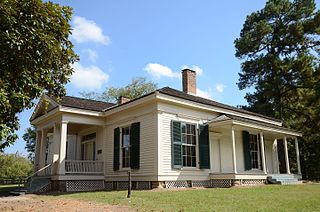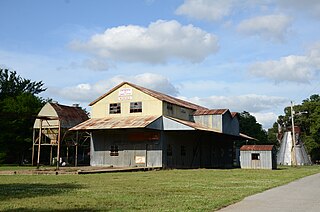
This is a list of properties and historic districts in Arkansas that are listed on the National Register of Historic Places. There are more than 2,600 listings in the state, including at least 8 listings in each of Arkansas's 75 counties.

List of the National Register of Historic Places listings in Nassau County, New York

The Confederate State Capitol building in Washington, Arkansas was the capital of the Confederate state government of Arkansas, during 1863–1865, after Little Rock, Arkansas fell to Union forces in the American Civil War. It is located within Historic Washington State Park, and is a National Historic Landmark.

The Union County Courthouse is a courthouse in El Dorado, Arkansas, United States, the county seat of Union County, built in 1927. It was listed on the National Register of Historic Places in 1983. The courthouse was built in the Classic Revival and Greek Revival styles by Mann & Stern and anchors the center of Union Square.

The Columbus Presbyterian Church was a historic church on Arkansas Highway 73 in Columbus, Arkansas.

Judd Hill is an unincorporated community in Poinsett County, Arkansas, United States. Judd Hill is located on Arkansas Highway 214, 5 miles (8.0 km) south of Trumann. The Judd Hill Cotton Gin, which is listed on the National Register of Historic Places, is located in Judd Hill. Judd Hill was named for banker and businessman Orange Judd Hill, who founded the community.

The Kemp Cotton Gin Historic District encompasses the only cotton gin extant in the Rohwer area of Desha County, Arkansas. The gin was built in 1950 by O. O. Kemp, a few years after the closure of the Rohwer War Relocation Center, where as many as 10,000 Japanese-Americans were interned during the Second World War. After the center's closure much of its land was returned to agricultural use, and Kemp built this gin near the Missouri Pacific Railroad line that ran through Rohwer. In addition to the gin, the complex Kemp built includes a pump house, scale house, and office. This entire complex was listed on the National Register of Historic Places in 2005.

The Hempstead County Courthouse is located at the northwest corner of 5th and Washington Streets in Hope, the county seat of Hempstead County, Arkansas. The five story masonry structure was designed by the Little Rock firm of McAninch and Anderson, and built in 1939 with funding from the Public Works Administration, a depression-era federal jobs program. It is Hope's finest example of Art Deco architecture. Its entry is framed by a series of molded concrete panels, separated by inverted chevrons. The panels depict a variety of industries and professions, including construction, mining, medicine, defense, electricity, farming, and brickmaking. Chevron paneling is repeated in the cornice. The interior of the building is virtually unaltered, except for two courtrooms on the upper floors, which required complete renovation following a lightning-induced fire in 1979. The 1939 building has had a large jail added, but this was done in a sympathetic manner to the original's design.

The Mounds Cemetery is a historic cemetery in rural Hempstead County, Arkansas. It is located off County Road 13, northwest of the small community of Columbus. It is significant as the site of two Caddoan mounds, and as the burying ground for some of Hempstead County's earliest white settlers. It is further significant as a stopping site along the Trail of Tears, the forced westward relocation of Native Americans in the 19th century.

The Grandison D. Royston House is a historic house at Columbus and Water Streets in Historic Washington State Park, Washington, Arkansas. It is a single-story wood frame structure, about 55 feet (17 m) wide and 51 feet (16 m) deep, with a hip roof pierced by two chimneys with corbelled tops. The main entry is centered under a projecting gable-roof porch, and is framed by sidelights and transom windows. The porch is supported at the front by pairs of square columns with moulded capitals and a square plinth. At the back of the house is a shed-roof addition which housed the kitchen. The interior of the main block is divided into four rooms, two on either side of a large central hall.

The Nesburt T. Ruggles House is a historic house in rural Hempstead County, Arkansas. It is a single story wood frame structure, located southeast of the hamlet of Shover Springs, on the east side of Arkansas Highway 32. It is a Plain Tradition structure with an American Craftsman-style hip roof, built in 1912-14 by Nesburt Ruggles, and is the best example of its style in the area. The house is clad in novelty siding, and is roughly rectangular, with projecting hip roof sections on the sides. A shed-roof porch stands in the right-side ell created by the front facade and the right projection.

The John H. Johnston Cotton Gin Historic District encompasses a historic cotton gin in the small community of Levesque, Arkansas. The main building of the gin was built in 1941, and was built out of reinforced concrete, instead of the more usual steel, owing to a metal shortage in World War II. It has some Moderne styling, with smooth surfaces and rounded corners. The gin also distinctively incorporates a seed storage facility at its rear. Its ancillary structures, which include a shed, privy, and cyclone structure, are wood-framed with metal siding and roofing.

The Weldon Gin Company Historic District encompasses a historic cotton gin complex in Weldon, Arkansas. With a history dating to 1833, the Weldon Gin Company was long a staple of the local economy. Located in the center of the town at the junction of Weldon and Washington Streets, the company complex includes a main gin building, built in 1939, and four outbuildings. The present mill was built to replace an earlier steam-powered mill after electricity was introduced to the area in the 1930s.

The Hanger Cotton Gin is a historic cotton gin in Sweet Home, Arkansas. Built about 1876, it is a rare surviving example of a steam-powered gin. The main building is a three-story frame structure covered in board-and-batten siding. The gin was only operated commercially for a brief period, and was out of service by 1892. Since then, the building has been used as a barn and grain storage facility. It was probably built by Peter Hanger, whose family has been prominent in the Little Rock business community since that time.

The Floyd Cotton Gin is a historic cotton gin at the junction of Arkansas Highway 31 and Arkansas Highway 305 in Floyd, Arkansas. It is a two-story wood frame building roughly L-shaped with a single-story section extending its southern end and a two-story section projecting east under a continuation of the sloping gabled roof. This gin was built in the 1930s, when White County was one of the nation's leading producers of cotton. It is one of five gins in the county to survive from that period.

The Stipe Cotton Gin is a historic cotton gin at Florida and Cypress Streets in Beebe, Arkansas. It is a two-story steel-framed structure, clad in corrugated metal, that houses the steam compressor and other equipment for processing and baling cotton. The complex also includes a seed storage building, and a circular structure of uncertain function. Built about 1930, it is one of only five to survive in White County from that period, when cotton production was locally at its peak.
Goodlett is a surname. Notable people with the surname include:




















